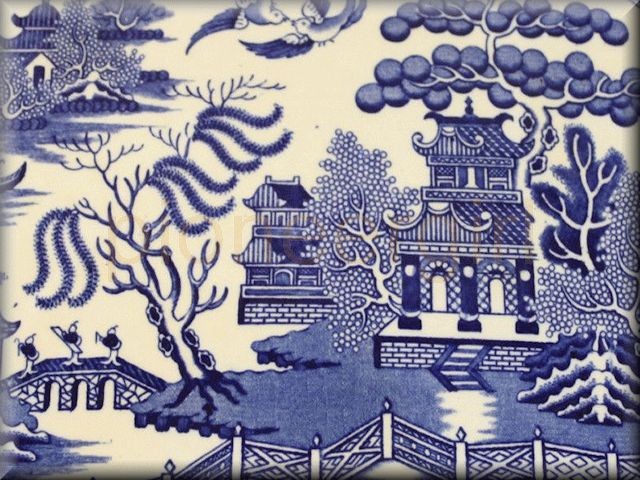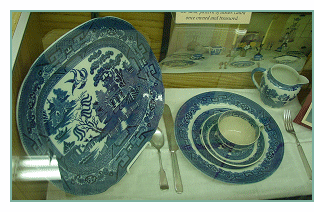willow-ware

Following the Revolutionary War, America was eager to trade with foreign countries. Ships sailing from the Chinese port known as Canton brought blue and white Canton china which soon became a favorite in the States. It featured a hand-painted three-ring border and a painted scene of sailing vessels, willow and pine trees, rocks, islands, an arched bridge, and Chinese buildings. This was followed by a more superior porcelain called Nanking china, then English blue (and other colors) willow-ware or willowware. The English china was transfer-decorated, not painted.
The Willow Pattern has been perhaps more popular and more universally familiar ever since the first use of the blue color in English potteries than any other design put upon tableware. A Chinese story inspired the potter-apprentice Thomas Minton, about the year 1780, to compose and engrave the design. Many versions of the story are told. The following is from Ada Walker Camehl’s The Blue-China Book: Early American Scenes and History (E.P. Dutton & Company, 1916), 287-289:
 The large pagoda at the right of the design is the palace of the wealthy Mandarin, while upon the terrace stands the summer house where Koong-Shee, the lovely daughter of the Mandarin, was kept a prisoner in order that she might be concealed from Chang, her father’s secretary, who loved her and whom she wished to marry. But Chang was poor and the Mandarin selected a wealthy suitor for his daughter’s hand. From her chamber in the prison the unhappy maiden watched the willow tree blossom while yet the peach tree was only in bud, and she wrote verses in which she voiced the hope that before the peach blossoms appeared, she might be free. Chang, however, found means to communicate with Koong-Shee, once by sending a note in a tiny cocoanut shell, which by the aid of a small sail made its way to the captive maiden. Koong-Shee replied by scratching on an ivory tablet the challenge, “Do not wise husbandmen gather the fruits they fear will be stolen?” and, putting the tablet in the boat, she sent it back to her lover.
The large pagoda at the right of the design is the palace of the wealthy Mandarin, while upon the terrace stands the summer house where Koong-Shee, the lovely daughter of the Mandarin, was kept a prisoner in order that she might be concealed from Chang, her father’s secretary, who loved her and whom she wished to marry. But Chang was poor and the Mandarin selected a wealthy suitor for his daughter’s hand. From her chamber in the prison the unhappy maiden watched the willow tree blossom while yet the peach tree was only in bud, and she wrote verses in which she voiced the hope that before the peach blossoms appeared, she might be free. Chang, however, found means to communicate with Koong-Shee, once by sending a note in a tiny cocoanut shell, which by the aid of a small sail made its way to the captive maiden. Koong-Shee replied by scratching on an ivory tablet the challenge, “Do not wise husbandmen gather the fruits they fear will be stolen?” and, putting the tablet in the boat, she sent it back to her lover.
Chang received the message, entered the Mandarin’s garden in spite of the barricades which had been erected to keep him away, and eloped with Koong-Shee. The father gave chase, and there on the bridge the three may be seen—Chang carrying a box of jewels, Koong-Shee with a distaff in her hand, and the angry Mandarin with a whip. The lovers escaped, however, entered the little boat, and sailed away to Chang’s house on the island, where they lived happily until the rejected suitor discovered them and burned their home. Then, from out of the ashes of Chang and Koong-Shee, who perished in their bamboo grove, there arose two spirits in the form of white doves—the lovers, who forever hover over the scenes of their earthly happiness.
 Nothing is known of the willow-ware platter carried by fictional Mother Wilder in Farmer Boy, or if she even owned such a pattern in real life. Laura and Almanzo Wilder, however, owned a set of blue willow-ware made by Charles Allerton & Sons. This set was much loved by Laura, who wrote a letter to daughter Rose to be opened after her death, which included the following: “…We were proud of my Haviland china but loved best the English made blue willow ware. Do as you please with all the china, but I wish you might use it…” [Letter from Laura Ingalls Wilder to Rose Wilder Lane dated July 30, 1952]
Nothing is known of the willow-ware platter carried by fictional Mother Wilder in Farmer Boy, or if she even owned such a pattern in real life. Laura and Almanzo Wilder, however, owned a set of blue willow-ware made by Charles Allerton & Sons. This set was much loved by Laura, who wrote a letter to daughter Rose to be opened after her death, which included the following: “…We were proud of my Haviland china but loved best the English made blue willow ware. Do as you please with all the china, but I wish you might use it…” [Letter from Laura Ingalls Wilder to Rose Wilder Lane dated July 30, 1952]
After Laura’s death, Rose gave the set to Laura’s friend Neta Seal, in Mansfield. Mrs. Seal kept the set until her death in 1996 (she used to let visitors hold it in their hands!), at which time it went to the Laura Ingalls Wilder / Rose Wilder Lane Home & Museum in Mansfield,Missouri. Pieces of the set are on display at the museum.
Charles Allerton & Sons.
Charles Allerton & Sons manufactured both earthenware and china in usual forms as well as gold and silver luster wares, both for home markets and export. Their pottery works were established in 1831, succeeding the firm of Allerton, Brough, & Green. After Charles Allerton’s death in 1863, his four sons continued the company under the original name. William was the only son remaining in the business by 1887. In 1912, the company was taken over by Cauldon Potteries Ltd; they operated under the name of Allerton’s Ltd. until 1942.

willow-ware (FB 2)

